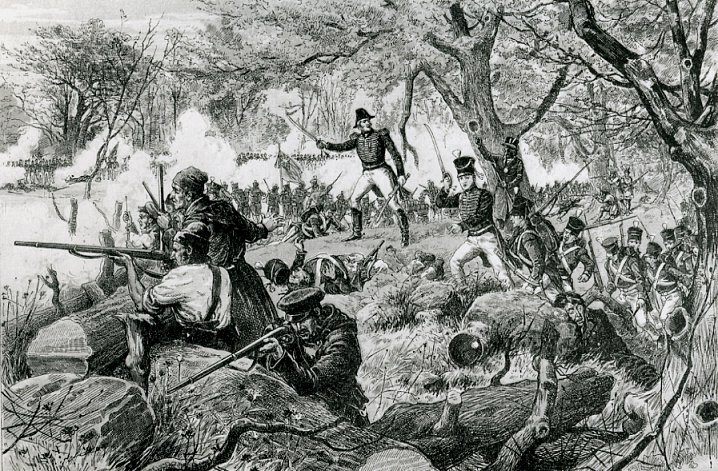It's been a while since I've updated the blog, mostly due to my being busy. I'm pretty active on Tumblr simply because it takes very little time or effort to post content there. For Veteran's Day, I gave a short talk and a musket demonstration at a school in Bettsville, Ohio. Bettsville is a little town south of Fremont and north of Tiffin, Ohio. It's actually only a couple of miles from Old Fort, the village on the site of Fort Seneca, where 800 of General Harrison's men camped in July and August 1813 while he waited for Commodore Oliver Hazard Perry's fleet to sortie from Presque Isle.
I gave a brief talk on the significance of Northwest Ohio in the War of 1812, and the different kinds of soldiers who fought. Then everyone followed me out to the playground for a couple of shots from my musket.
November 11th also marks the 200th anniversary of one of the worst defeats suffered by American arms during the war. The Battle of Crysler's Farm was part of a two-pronged advance on Montreal by American armies under Major Generals Wade Hampton and James Wilkinson. Unlike in 1812, most of the American troops were now regular soldiers, some from regiments that had seen battle and been drilled-- others raw recruits. With overwhelming numbers and professional soldiers, Secretary of War John Armstrong hoped to pinch shut the lifeline into Western Canada and seal the victories that William Henry Harrison, Winfield Scott, and Zebulon Pike had won for him in the west.
 |
| The Battle of Chateauguay. |
It didn't work out. Late in October, Hampton's troops got bogged down in swamps and were turned back by a smaller British-Canadian force. Wilkinson's troops were tailed down the St. Lawrence by a smaller detachment under Lt. Colonel Joseph Morrison. This was a Corps of Observation rather than a true army, meant to shadow and harass the Americans as they advanced. On November 11, however, Wilkinson ordered his rear guard commander, Brig. General John Boyd, to turn back with most of his army and drive off the British. The ensuing battle is best summarized by this animated presentation:
Here are a couple of maps I drew of the battle, from an earlier post:
In the earlier post I remarked on the impact that Duane's Manual for infantry might have had on the battle. Duane's manual was essentially an update to Smyth's 1812 translation of the 1791 French manual, even though the two men did their work around the same time. William Duane, a Republican politician, fervent Irish nationalist, newspaper publisher, and Colonel of the regular Rifles regiment, had adapted the latest Napoleonic tactics into his drill.
The differences only become apparent if you use them to drill as period infantry, so reenactors are at a better position to understand why Crysler's Farm fell out as it did than most military historians. Duane introduced the "line of science", which made it much easier for men in line abreast to march at an angle without changing the direction of the company or battalion front. He also introduced a new method of firing in three ranks: the rear rank man only loaded and handed his musket forward to the second rank man, who only had to load half of his rounds. The front rank man was able to remain standing, which improved his aim and the time it took for him to reload.
Duane lacked battlefield experience, and only got his information second-hand from Europe, but his notes on fire in combat are interesting: "In real service it is impossible, after the first fire, to keep up a regular volley, or platoon fire...the practice now in all armies is the fire deliberate and composed as each man loads." Firing with all three ranks, he claimed, caused too many front rank men to get their heads blown off by their file mates!
Someone was reading Duane, despite claims by historians that his drill book was unpopular and little-used in the army. Several of the American regiments at Crysler's Farm deployed in columns in their efforts to get around the British flank. Several got bogged down with individual firing, which tends to disrupt a maneuvering battalion. It suggests a force that was drilled under Duane's manual, but without enough experience to reform, stop firing, and push ahead as an effective mass.
The "green" Americans have been universally compared with the professional soldiers in the British line when historians summarize the battle. However, it's important to remember that the Americans had formed into three brigades. General Boyd, competent at best, wanted to send columns around the British flank while tying their two battalions down with a frontal attack. But the more complex a plan, the more things can go wrong.
Expecting two columns to push through light infantry opposition and arrive simultaneously with the demonstrating force in front was too much to expect of any horse-and-musket army in broken ground, much less the inexperienced Americans. It sounds more like something the French Army of the time could pull off, but only with solid combined-arms support. Second hand experience like the kind that Duane peddled was no replacement for years of large scale campaigning.




No comments:
Post a Comment
Note: Only a member of this blog may post a comment.